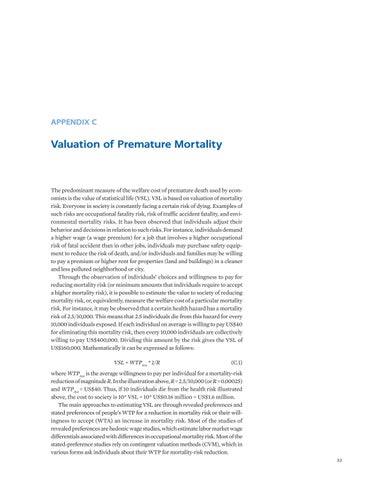APPENDIX C
Valuation of Premature Mortality
The predominant measure of the welfare cost of premature death used by economists is the value of statistical life (VSL). VSL is based on valuation of mortality risk. Everyone in society is constantly facing a certain risk of dying. Examples of such risks are occupational fatality risk, risk of traffic accident fatality, and environmental mortality risks. It has been observed that individuals adjust their behavior and decisions in relation to such risks. For instance, individuals demand a higher wage (a wage premium) for a job that involves a higher occupational risk of fatal accident than in other jobs, individuals may purchase safety equipment to reduce the risk of death, and/or individuals and families may be willing to pay a premium or higher rent for properties (land and buildings) in a cleaner and less polluted neighborhood or city. Through the observation of individuals’ choices and willingness to pay for reducing mortality risk (or minimum amounts that individuals require to accept a higher mortality risk), it is possible to estimate the value to society of reducing mortality risk, or, equivalently, measure the welfare cost of a particular mortality risk. For instance, it may be observed that a certain health hazard has a mortality risk of 2.5/10,000. This means that 2.5 individuals die from this hazard for every 10,000 individuals exposed. If each individual on average is willing to pay US$40 for eliminating this mortality risk, then every 10,000 individuals are collectively willing to pay US$400,000. Dividing this amount by the risk gives the VSL of US$160,000. Mathematically it can be expressed as follows: VSL = WTPAve * 1/R
(C.1)
where WTPAve is the average willingness to pay per individual for a mortality-risk reduction of magnitude R. In the illustration above, R = 2.5/10,000 (or R = 0.00025) and WTPAve = US$40. Thus, if 10 individuals die from the health risk illustrated above, the cost to society is 10* VSL = 10* US$0.16 million = US$1.6 million. The main approaches to estimating VSL are through revealed preferences and stated preferences of people’s WTP for a reduction in mortality risk or their willingness to accept (WTA) an increase in mortality risk. Most of the studies of revealed preferences are hedonic wage studies, which estimate labor market wage differentials associated with differences in occupational mortality risk. Most of the stated-preference studies rely on contingent valuation methods (CVM), which in various forms ask individuals about their WTP for mortality-risk reduction. 53

